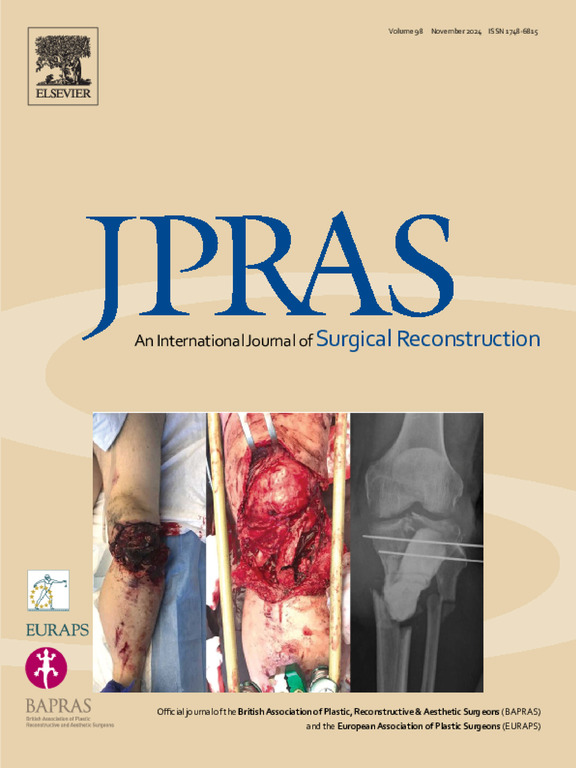患者提交的非黑色素瘤皮肤肿瘤照片改善了术前分诊
IF 2.4
3区 医学
Q2 SURGERY
Journal of Plastic Reconstructive and Aesthetic Surgery
Pub Date : 2025-07-29
DOI:10.1016/j.bjps.2025.07.033
引用次数: 0
摘要
随着对手术治疗的需求,非黑色素瘤皮肤癌的发病率正在迅速增加。大多数病变可以通过当天检查和简单手术治疗,而更复杂的病例需要先进的程序和单独的术前检查。然而,推荐信往往不能准确地传达病例的复杂性,导致不必要的医院手术计划访问,最终只需要简单的程序。有效的分诊对于指导患者找到合适的治疗途径至关重要。本研究在一项前瞻性队列研究中评估患者提交的照片是否可以提高非黑色素瘤皮肤癌手术计划的效率和准确性。患者被邀请提交照片,并使用移动应用程序“Mit Sygehus”完成一项简单的调查。数据从电子医疗记录中提取,用于分析六个月基线期的分诊模式、18个月研究期间对研究邀请的响应率,以及使用适当的统计检验分析应答者和无应答者之间的差异。在基线组中,116名患者被分类为手术计划,但最终接受了没有重建手术的小手术,这表明他们可能受益于照片辅助分类。在研究组中,201名患者有资格进行照片辅助分诊,因为从转诊信中不清楚哪种治疗是合适的。我们有95名患者回应了邀请,其中50人直接接受了手术治疗。应答者与无应答者相比,等待治疗的时间更短。总之,患者参与远程医疗改善了术前分诊,减少了非黑色素瘤皮肤癌患者的住院次数和手术时间。本文章由计算机程序翻译,如有差异,请以英文原文为准。
Photographs of non-melanoma skin tumours submitted by patients improve preoperative triage
The incidence of non-melanoma skin cancer is rapidly increasing, along with the demand for surgical treatments. Most lesions can be treated with same-day examination and simple surgery, while more complex cases require advanced procedures and a separate pre-surgical visit. However, referral letters often fail to convey case complexity accurately, resulting in unnecessary hospital surgical planning visits for cases that ultimately require only simple procedures. Efficient triaging is essential to direct patients to the appropriate treatment pathway. This study evaluates whether patient-submitted photographs can improve the efficiency and accuracy of surgical planning for non-melanoma skin cancer in a prospective cohort study. Patients were invited to submit photographs and complete a simple survey using the mobile application 'Mit Sygehus'. Data were extracted from electronic medical records and used to analyze triage patterns during a six-month baseline period, response rates to the study invitation over an 18-month study period, and differences between responders and non-responders using appropriate statistical tests. In the baseline group, 116 patients were triaged for surgical planning but ultimately underwent minor procedures without reconstructive surgery, suggesting they could have benefited from photo-assisted triage. In the study group, 201 patients were eligible for photo-assisted triage, as it was not clear from the referral letters which treatment would be appropiate. We had 95 patients responding to the invitation with 50 of these triaged directly to surgical treatment. Responders had shorter wait times to treatment compared to non-responders. In conclusion, patient involvement in telemedicine improves pre-surgical triage, reducing hospital visits and time to surgery for patients with non-melanoma skin cancer.
求助全文
通过发布文献求助,成功后即可免费获取论文全文。
去求助
来源期刊
CiteScore
3.10
自引率
11.10%
发文量
578
审稿时长
3.5 months
期刊介绍:
JPRAS An International Journal of Surgical Reconstruction is one of the world''s leading international journals, covering all the reconstructive and aesthetic aspects of plastic surgery.
The journal presents the latest surgical procedures with audit and outcome studies of new and established techniques in plastic surgery including: cleft lip and palate and other heads and neck surgery, hand surgery, lower limb trauma, burns, skin cancer, breast surgery and aesthetic surgery.

 求助内容:
求助内容: 应助结果提醒方式:
应助结果提醒方式:


